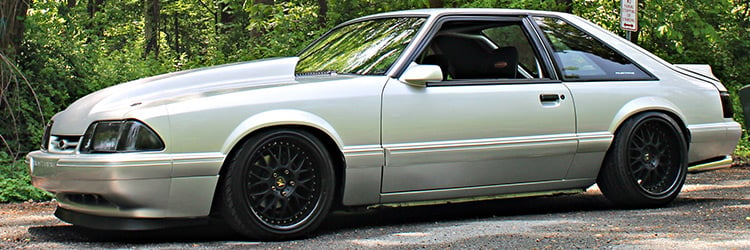The 351W swap is what we like to call an 'almost direct-fit swap'. Sounds like a typical marketing gimmick to me... Truth be told, it isn't too difficult to swap. Most of the 302 parts swap over, but there are some that do need to be changed. All the major stuff will drop right in, no modification to the engine bay or k-member needed. What parts do need to be swapped? Let's dive in.
Oil pan: The stock 351W oil pan is a front-sump, whereas the 302 uses a rear-sump. Thus, the 351W oil pan needs to be changed to a rear-sump (like the 302) in order to fit in your Mustang (otherwise it will not clear k-member). Ford Racing has a good 5-quart kit available, or there are larger offerings from Canton or Moroso, in the order of 7-quarts and with the option of a wind-age tray.
Oil pump, shaft, pickup: A new oil pump and shaft is cheap insurance, whereas a new pickup will be necessary (remember, we went from front-sump to rear-sump), the original 351W pickup will not work.
Flywheel and harmonic damper: Ford's 351W uses a 28oz imbalance versus a 302's 50oz imbalance, thus meaning you will need both a new flywheel and harmonic damper. In this case, you're looking for a 157-tooth 28 oz flywheel to use with a 10.5" clutch . Also, the flywheel bolt pattern differs. An alternate option is to have a machine shop trim the 50 oz imbalance down to 28 oz and re-drill the mounting holes in the correct locations.
Distributor: The distributor too needs to be changed, as the 351W has a larger oil pump drive shaft as well being physically taller. Grab a dizzy from any EFI 351W (5.8L) truck out of a scrapyard, or any aftermarket vendor will be more than willing to sell you a brand new one as well. It should also be mentioned, if you are using a roller cam, swap the stock cast-iron distributor gear for one of steel.
Exhaust manifold/headers: Fox style headers, be it short or long tube, will not work due to clearance issues. Instead, you must seek a set of headers labeled as '351W swap headers'. It is easier (and cheaper) to get shorty headers, but I believe there are some long-tube conversions out there as well. Check out companies like Ford Racing, Kooks, Hooker, BBK etc. There are even sets available on eBay, however I cannot attest to their quality (but check out their feedback, it could be worth it).
Intake manifold: A 351W has a greater deck height and separation, thus rendering any 302 lower intake useless. It simply will not bolt up because they are not physically wide enough to bridge the gap. Rather, you will need to find a specific 351W lower intake. However, this isn't really a problem as all major aftermarket companies offer them (Ford Racing, Edelbrock, Trickflow, Holley etc). On a side note, 302 heads will work without any issues, just the bolt-holes will need to be enlarged to fit 1/2" fasteners.
Accessory brackets & crank spacer: The last items that are not a direct swap are accessory brackets, namely the power steering and AC bracket. Depending on what accessories you are running, some of the 302 brackets will not fit. Ford Racing sells a replacement kit with the right geometry for around $60-$70, as does March. Furthermore, a crank spacer may also be necessary to help align your accessories and serpentine belt. Some guys are able to make it worth with just the regular 5.0L parts, whereas others can't. As mentioned, it depends on what accessories you wish to run, and where you want to place them.
The above parts are what is needed to get a 351W to both fit and run inside of your Fox or SN95 Mustang. However, there are still a ton of other factors that need to be addressed, but are not directly involved with the swap. For instance, if you plan on making more power (which is the whole idea of using a 351), you'll need a fuel system to match. Larger injectors or carb, more powerful fuel pump, throttlebody etc.
